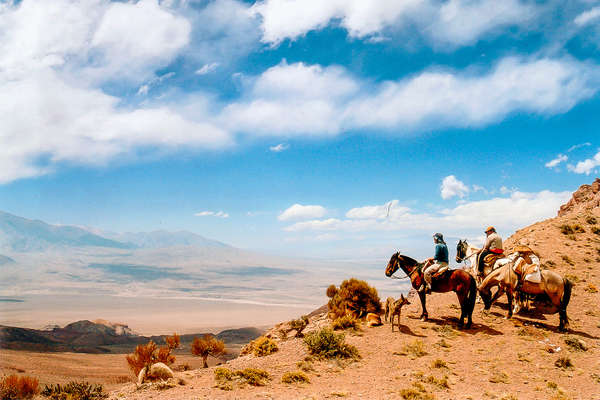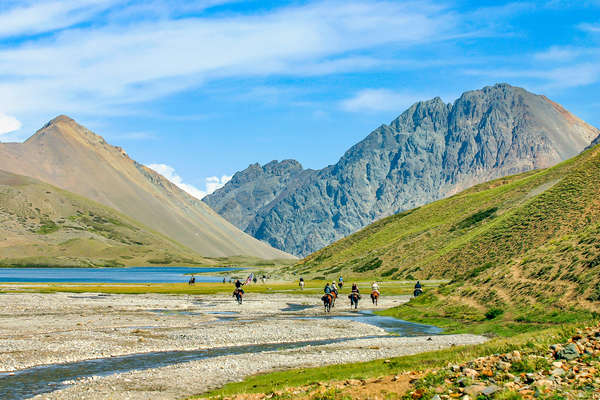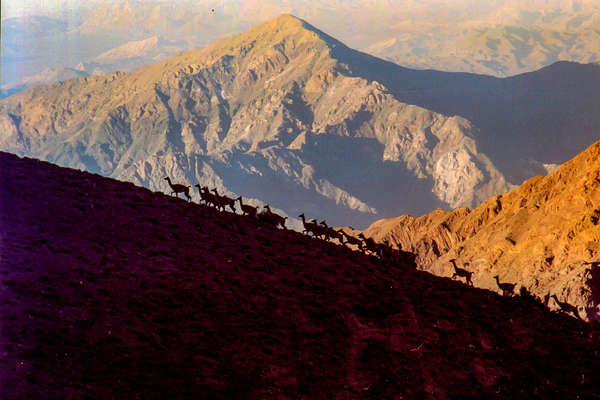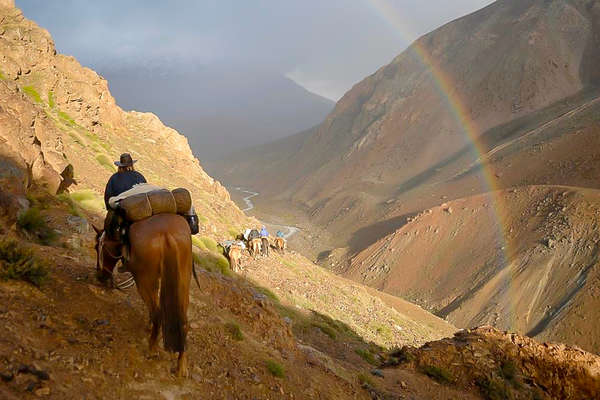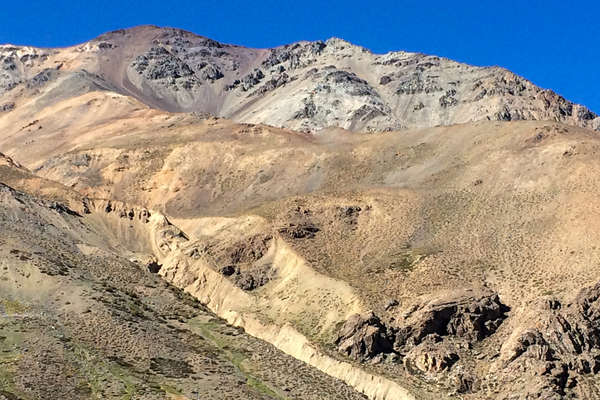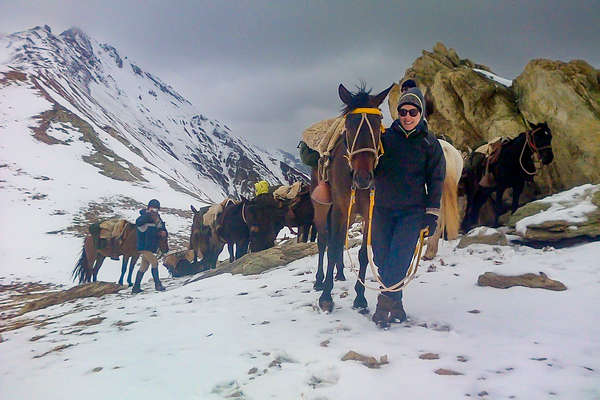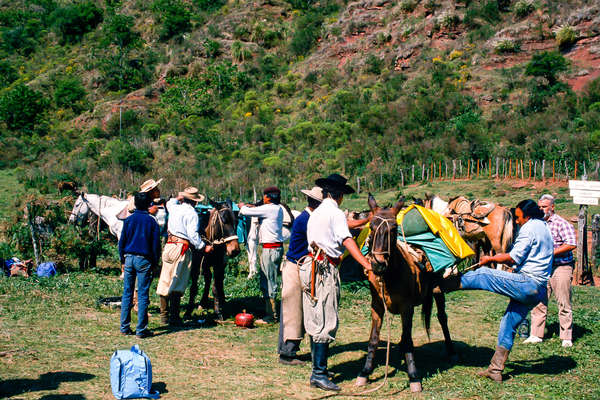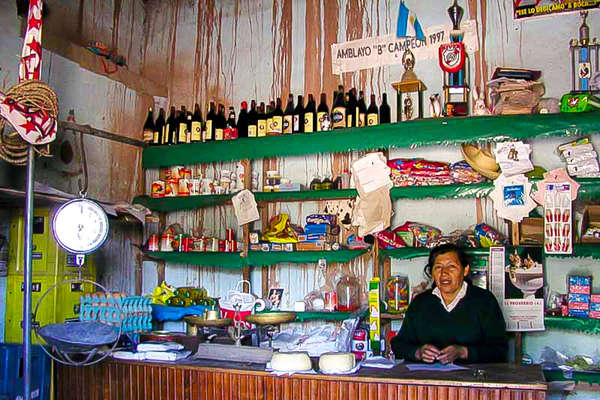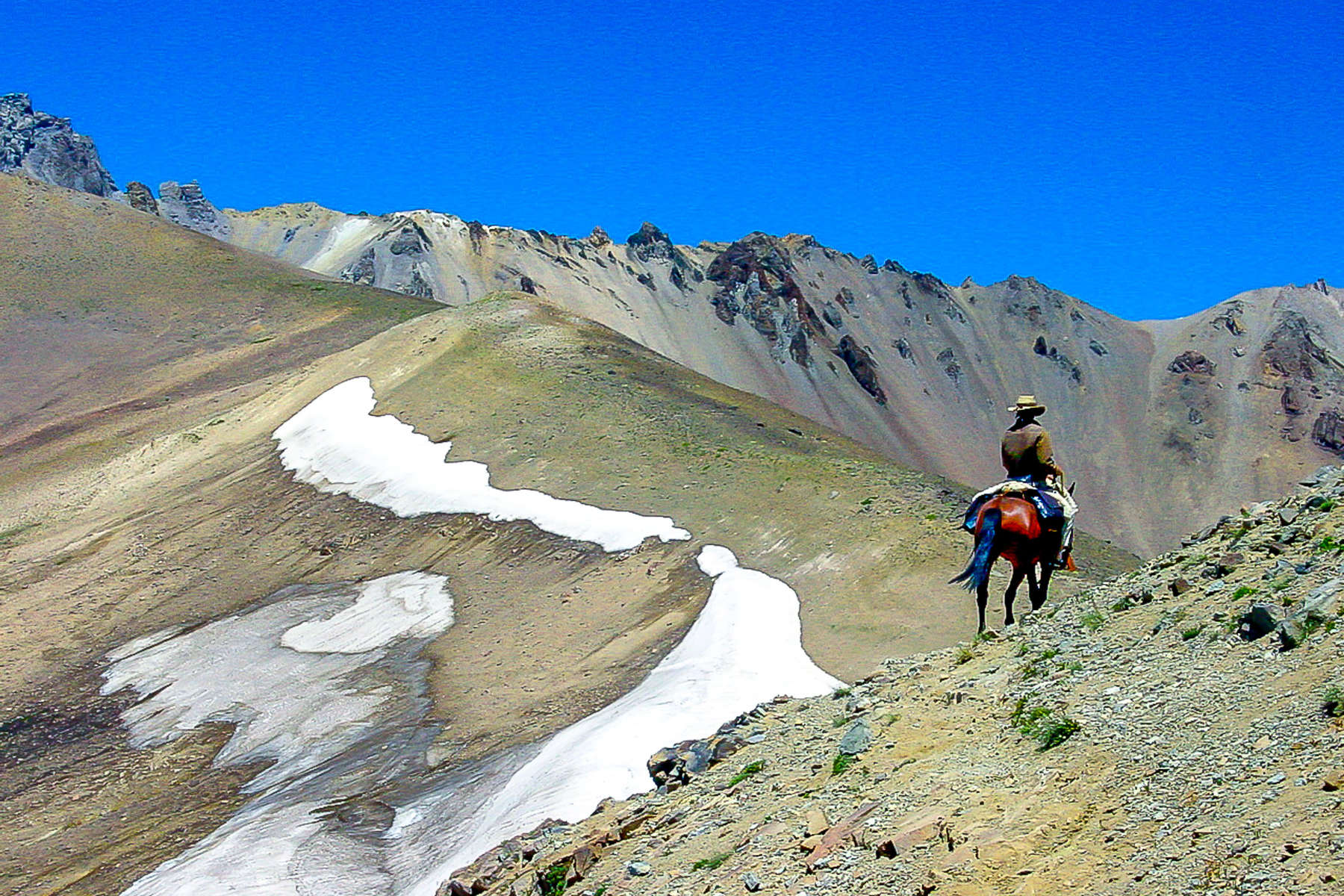
From the horse’s mouth
Itinerary
Highlights
- An exclusive chance to cross the border with special permission from the Argentine and Chilean authorities
- Change horses at the border in accordance with Chilean and Argentine law, so experience the incredible Criollo from both countries
- Amazing landscapes and mountainous passes, including seeing the largest peak in South America - Aconcagua
- Tour a vineyard in Mendoza and sample their world-renowned wines
- Possibility to explore Santiago de Chile and/or Buenos Aires if you have time for extra days
Dates & prices
Price details
- Flights or transportation to your destination (international/domestic) are not included, but can be booked on request - please contact us for rates.
- Rates are per person, based on two riders sharing a twin or double room/tent during the ride.
- Groups are composed of a minimum of 5 riders and a maximum of 15 international riders, plus guides.
- There is a small group supplement payable if the group is less than 6 riders:
For groups of 4-5 riders the supplement is c. €835/£700/$900 per person.
For groups of 2-3 riders, the supplement is c. €1750/£1480/$1900 per person.
- If you end up in a single room/tent then there is a single supplement payable (c. $350/€340/£300). This will be invoiced to you when you book and refunded once a sharer is found.
- It may be possible to rent a sleeping bag for $25/€23/£20 per sleeping bag. Please ask your travel advisor in advance. A sleeping mat is free of charge.
Please Note
The itinerary may be modified at anytime for security reasons, meteorological or events beyond our control such as blocked roads, rivers in flood, drought, strikes and local holidays. Equus Journeys, our local partners and their local guides will always strive to find the best solution and will alter the itinerary as needed.
The names of the hotels and accommodation are given for information only and depending on availability, they may be modified without notice and replaced by another of a similar standard.
Price includes
Support Team
1 assistant guide
Logistic
Guides and gauchos in charge of the horses
pack mules
Inland transports
all inland transports
Accommodation
2 persons in a 3 men tent or 3 persons in a 5 men tent
Meals
Mineral water and wine served at meal time during the trek
Additional equipment
Iridium satellite phone for emergency calls
First aid kit and oxygen bottles
Price doesn't include
Meals
Beverage and personal extra
Transports
Domestic flights Mendoza - Santiago
International airport exit fees
Extra
Small group supplement
Insurance
Optional
Accommodation
Extra
Equestrian info
Horses
The tack is traditional gaucho saddles with sheepskin covers for comfort.
Rider weight limit: 100 kilo/15 st 5 lbs/200 lbs. Heavier riders please contact us.
Guide & local team
Minimum riding ability
Minimum riding ability
Pace
Tacking ability and participation
Trip conditions and Requested experience
You need to remember that you are a long way from civilisation and medical help. All medical conditions, allergies and other specific requirements must be disclosed before booking this trip.
If you have a medical condition we will require a certificate from your physician authorising you to do the ride. Tell your doctor that you are going to be riding and camping at 4500 mts. (13 500 ft.) altitude.
There can be extreme temperature variations in the mountains - up to 30c in the day and dropping to -5c at night. It can be sunny but it can also be very windy!
Your belongings are carried by pack horses. You must have previous experience of camping trails lasting at least a couple of days. Previous experience of a riding trail would be advantageous too.
Equestrian equipment
South American Recado saddles, comfortable for long rides.
Riding helmets, chaps or rain capes are NOT available and you must bring your own.
Travel info
Comfort
There are no bathrooms and no showers on the trail. The first and last night are spent in hotels.
Meals
Vegetarian diets can be accommodated with plenty of advance notice - let us know at the time of booking. Vegan and coeliac diets cannot be accommodated on this trail unless willing to bring your own camping meals.
WATER
You collect your own water from the rivers you pass along the route - the water is clean and pure. Camps are always situated near to fresh water and you cross rivers during the day where you can also re-fill your water bottles. You may wish to take water purification tablets such as Micropur for the water if you are worried.
Climate
Daytime temperatures can be high (10-30c), but night temperatures are cold and can drop to below freezing at high altitudes. You will need to be prepared for extreme temperatures and the mountains can throw inclement weather at you with no warning. It can also be windy, so good mountain clothing is essential.
Before/after the ride in Santiago/Mendoza/Buenos Aires, the weather can be hot and sunny.
Tips
Packing list
The luggage weight limit per person is 10 kilos. Before you start the ride, you will be given saddlebags where you can pack all the clothing you will carry for the ride. In this ride, you start the trip on one location and end it on another in another country. Therefore, as the rest of your luggage has to be carried on mules, please use a flexible bag and not hard cases.
Head
- Equus Journeys strongly recommend that you wear a riding helmet and that you take your own to ensure a correct fit.
- Sunhat for when not riding
- Sunglasses - with a cord attached so they don't fly off when riding
- Buff or bandana for protecting your neck and face from the sun and dust
- Warm hat
Upper body
- Thermals in case of cold weather (can also be worn at night)
- Down jacket or warm coat for the cold evenings
- Long sleeved shirts provide protection from the sun
- T-shirts
- Lightweight fleece or jumper
- Warm polar fleece or equivalent (plus a spare in case one gets wet)
- Waterproof jacket - rain can be difficult to predict and it's better to be prepared.
Legs
- Lightweight, comfortable riding trousers or jodhpurs - we recommend riding in them at home before taking them on holiday to ensure they don't rub
- Waterproof over trousers
- Casual clothes for the evenings (jeans or walking trousers)
- Thermals in case of cold weather
Hands and Feet
- Comfortable riding boots. We recommend short boots with half chaps but you may wish to take long chaps. We don't recommend taking your favourite long leather boots in case they get damaged
- Lightweight shoes or trainers for the evenings
- Good walking boots (or hybrid walking/riding boots)
- Several pairs of warm socks
- Gloves - your hands are particularly exposed to the sun, wind or rain whilst riding
Nightwear
- Sleeping bag with a comfort rating of at least minus 5c, preferably minus 10c. We also suggest adding a liner, such as silk or fleece for extra warmth
- Thermarest pad or similar insulating mattress
Our Recommendations
- You should use a soft sided suitcase which can easily be transported - we recommend a large backpack or rucksack of c. 60-80 litres. Remember that your luggage is carried by pack horses!
- Backpacks cannot be worn whilst riding. We recommend a small bumbag or a coat with pockets so that you can carry small items with you during the day (camera, sunscreen, lipbalm etc)
- We recommend travelling in your riding boots and carrying your hat and some riding clothes in your hand luggage - then if your luggage goes astray you are still able to ride!
- Please be aware that internal flights in Argentina may have a lower luggage allowance than your international flight and you should pack according to the lowest limit.
Other useful items
- Swimsuit - for swimming/bathing in rivers
- Camera and high capacity memory card. Spare battery
- Bumbag for carrying your camera and small items whilst riding
- Headtorch or small torch for moving around camp at night - bring spare batteries and bulbs
- Ear plugs (for light sleepers)
- Water bottle - 2 x 1 litre, or equivalent
- Wet wipes for when washing water isn't available
In your luggage
- Any liquids, such as shampoo, moisturiser, deodorant unless they are less than 100ml and all bottles can fit in a small, clear, plastic ziplock bag.
- Swiss army knife or equivalent
- Lighter for burning toilet paper
In your hand luggage
- Any valuables, such as your camera, ipod, ipad etc.
- Your riding hat
Medical kit
- Sunscreen and lip balm - should be high factor
- Insect repellent
- Any medication you regularly take
- Blister plasters in case of any rubs
- Antiseptic cream, plasters, aspirin, anti-histamine, insect-bite salve etc...
- Spare prescription glasses/contact lenses
- Eye drops
- Imodium or similar anti-diarrhoea medication
- Micropur or similar water purification tablets
- Re-hydration sachets
- Antiseptic wipes
- Handwash gel
- Toilet paper
Sustainable tourism
- Travel light. It's a little known fact, but the lighter you pack, the better for the environment as heavy bags will produce higher emissions (when flying a plane or driving a car!).
- Reduce plastic waste. Take your favorite reusable bottle with you. Avoid single-use bags, cups, or straws.
- Preserve nature. Always take your rubbish with you during the ride and recycle them. Leave all the flowers or plants as you found them, and never get too close when observing wildlife. Make sure to use eco-friendly products such as body wash or laundry detergent (if camping) to protect both your skin and the environment.
- Choose your experiences carefully. Respect animal life by not participating in any activities that abuse wild animals (shows, elephant rides, etc.).
- Support local populations. Buy local handicrafts, be respectful of customs, and learn about the culture of local communities.
- Share! Raise awareness among your family and friends about sustainable tourism.
Did you know?
Did you know?
In January 1817 General Jose de San Martin set out to cross the Andes with a combined army of Argentine soldiers and Chilean exiles, in order to librate Chile from Spanish rule. Considered to be one of the most significant events in the Argentine and Chilean wars of independence, the crossing took 21 days.
They set out from their base camp El Plumerillo on January 19th 1817 with 4,000 men. Sadly only two thirds survived the 500km crossing to succesfully enter Santiago, Chile on February 13th 1817.
The Spanish Royalist forces blocked San Martin's advance at Chacabuco valley near Santiago where the famous Battle of Chacabuco took place on February 11th. San Martin split his army into two groups and sent them down paths at dawn. By the afternoon 500 Spanish soldiers were dead and 600 taken captive. San Martin lost only twelve men in battle but another 120 later lost their lives as a result of wounds received during the battle.
San Martin's main troop crossed the pass at Los Patos, which you reach on your 7th day of riding along this trail. His second troop crossed slightly further south at Uspallata.

